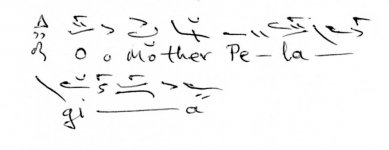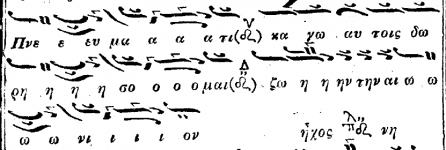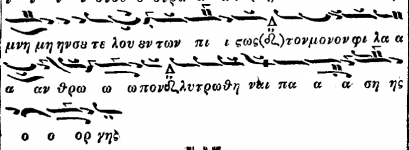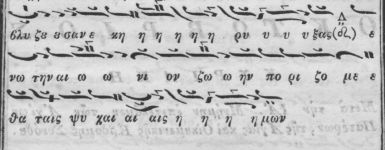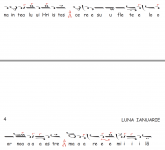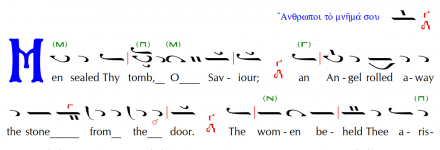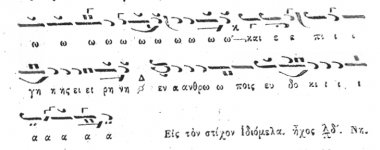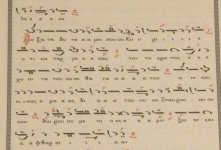Basil,
Thank you for your comments and suggestions. I’ve fixed the inconsistent spelling of “Romanos/-us” on my website.
Regarding the orthography of the final cadence in the Doxastikon at “Lord, I have cried,” you’ll notice that Papa Ephraim has a footnote for the rule you cited, which states: “Although Hourmouzios Hartophylax followed this rule, Gregorios the Protopsaltis and Theodore "Phoakaeus" did not. Instead they would put both kentēmata above the oligons in this example.” I’m simply choosing to follow the convention of Gregorios in this case, rather than Chourmouzios. (This is also the way this formula is written in the 1820 Anastasimatarion of Petros Ephesios. The 1820 Syntomon Doxastarion prefers the way you recommend, although even it is inconsistent; you can see how the exegete writes the final cadence of the Doxastikon of the Aposticha of Christmas, Εὐφράνθητι Ἱερουσαλήμ, in the way that I have it.) In any event, it seems to me that there appear to be two orthographically acceptable ways of writing this formula, since Hourmouzios favors one way and Gregorios another.
The question of the final cadence in the Doxastikon is, obviously, a much bigger question, and I appreciate your insight into the different ways we can approach this problem. Personally, I would prefer not to invent a new cadence (even given the precedent that exists in other languages) when an existing cadence from the Greek repertoire will do the job. I don’t find Suceveanu’s solution to be convincing, mostly because the fact that it is so obviously a splicing of two different formulas sticks out to me like a sore thumb. So, rather than creating something new, I would find it preferable to use an existing formula that satisfies the requirements of the text we are working with.
Then it becomes a question of whether or not the formula I have chosen is suitable or not. I am sympathetic to the argument you make about it being used infrequently in Greek settings. If we examine the Doxastarion of Petros the Peloponnesian (whose works essentially define the short sticheraric compositional genre), we will find 99 pieces in sticheraic Plagal 4th Mode that we can examine. Out of those 99 pieces, he used the cadence in question 7 times, in the following hymns:
- November 30th - Ὑπόδεξαι Βηθλεέμ ("Both Now" at the Praises). «Πᾶσα πνοή, αἰνεσάτω τὸν παντουργέτην.»
- Royal Hours of Theophany - Πρὸς τὴν φωνὴν τοῦ βοῶντος ἐν τῇ ἐρήμῳ (Doxastikon at the 1st Hour). «ὁ αἴρων τοῦ κόσμου τὴν ἁμαρτίαν.»
- Royal Hours of Theophany - Ἡ τοῦ Προδρόμου καὶ Βαπτιστοῦ (Idiomelon at the 3rd Hour.). «καὶ ἡ εἰρήνη τοῦ κόσμου.»
- Sunday of the Publican and the Pharisee - Παντοκράτορ Κύριε (Doxastikon at "Lord, I have Cried.") «σὺν αὐτοῖς ἀριθμήσας, ἐλέησόν με.»
- Sunday of the Last Judgment (Meatfare) - Ὅταν τίθωνται θρόνοι (Doxastikon at "Lord, I have Cried.”) «ἐπιστρέψας ἐλέησόν με.»
- Orthros of Holy and Great Friday (The 12 Gospels) - Οἱ νομοθέται τοῦ Ἰσραήλ (3rd Troparion at the 12th Antiphon) «καὶ ἡ εἰρήνη τοῦ κόσμου.»
- Royal Hours of Theophany - Οἱ νομοθέται τοῦ Ἰσραήλ (Idiomelon at the 6th Hour) «καὶ ἡ εἰρήνη τοῦ κόσμου.» This one is particularly interesting to me, because the Doxastarion of Petros contains two settings of this hymn, with different melodic material throughout each setting, but he uses the same concluding phrase each time.

Now, we could look at this and say, “this cadence is used rarely; it only shows up 7% of the time in the Doxastarion of Petros (and not at all in his Anastasimatarion), but I don’t think those numbers tell the whole story. The fact that it’s only used 7% of the time is because only 7% of the texts under consideration have a concluding phrase where the accent falls on the 2nd-to-last syllable: παντουργέτην (0010), ἁμαρτίαν (0010), εἰρήνη τοῦ κόσμου (010010), ἐλέησόν με (01010), etc. All of the other texts end with typical phrases and words like ὑπὲρ τῶν ψυχῶν ἡμῶν (0100101), τὸ μέγα ἔλεος (010100), Κύριε δόξα σοι (100100), or all of the various other types of accentuation patterns that can take the more typical Plagal 4th ending. I would argue that that the cadence is rarely used not because it doesn’t work very well or doesn't invoke the feeling of the mode; rather, it’s rarely used simply because it doesn’t fit the accentuation patterns of the ending phrases of the vast majority of troparia in sticheraric Plagal 4th Mode.
After checking the Doxastarion, I decided to look at Petros’ Slow Heirmologion as well, to see if it could contribute any additional insights into this discussion. After surveying the Plagal 4th slow katavasies of several feast days - whose melodic style is nearly identical to Plagal 4th sticheraic - I found the same treatment as in the Doxastarion: every time a concluding phrase ended with a word accented on the 2nd-to-last syllable, Petros used the same cadence as in the examples cited above. (The slow katavasies in Plagal 4th can be found on pages 117-134 of the aforementioned Heirmologion.) This leads me to conclude that this is not a “rare” cadence that we should hesitate to apply wholesale in English; it is simply the final cadence for a textual pattern that occurs infrequently in Greek. That, however, is the domain of hymnography, not composition.
Now, as to whether or not the cadence in question feels appropriately “final” or not: I would argue that the “standard” Plagal 4th ending cadence doesn’t feel particularly “final,” either. (For clarity, I’m referring to the one below.)
Yes, this formula is used very frequently as a final cadence. However, it’s not used exclusively for that, as can be seen by a survey of Petros’ settings in Plagal 4th Mode; we will encounter it used in the main body of various pieces as well. So this cadence is not exclusively “final;” we’re just used to hearing it used more frequently in that context, but that’s not the only place we find it, and there are parallels to this in 1st Mode and Plagal 2nd as well.
You mentioned the fact that this formula briefly cadences on Pa as one of the factors that leads to its feeling of finality, but I don’t find that to be necessary, either - we can also encounter final cadences like this one (from May 21st - Saints Constantine and Helen, Doxastikon at the Praises), which don’t sit on Pa at all:
Or cadences such as this one, which don’t really sit on Pa for any longer than the formula that has been discussed at length above:
My final argument for the suitability of the cadence I chose is the parallel that exists in Plagal 2nd Mode. As in Plagal 4th Mode, the vast majority of Plagal 2nd Mode hymns have texts that take the typical final cadence we are accustomed to hearing:
However, when a Plagal 2nd sticheraric hymn ends with a text that has an accent on the 2nd-to-last syllable, Petros chooses to use the hard chromatic equivalent of the cadence under discussion:
Given all of the facts stated above, I don’t see the necessity of creating a new cadence to invoke a more “typical” Plagal 4th final ending sound for the piece in question.




